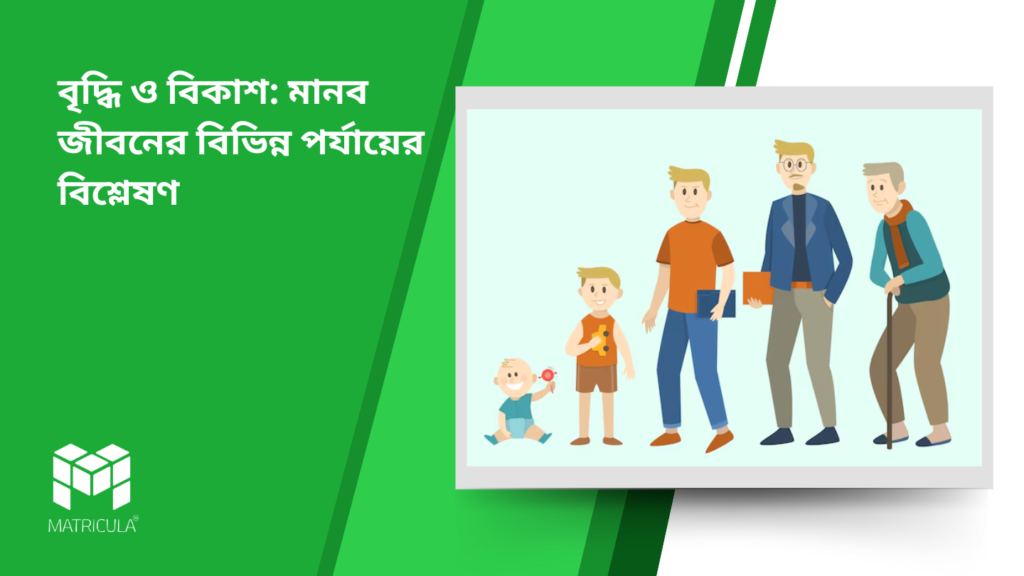Introduction
Growth and development are fundamental biological processes that define the journey of life. In humans, these processes occur in a systematic and progressive manner, shaping physical, mental, and emotional attributes over time. While growth refers to the quantitative increase in size and structure of an organism, development encompasses qualitative changes, including cognitive abilities, emotional maturity, and social behavior.
In this article, we will explore the concept of growth, differentiate it from development, and discuss the phases of human development—infancy, childhood, adolescence, adulthood, and senescence.
Concept of Growth and Development
What is Growth?
Growth is the increase in size, mass, and number of cells, leading to a visible change in the body structure. It occurs due to cell division and enlargement, which contribute to height, weight, and organ development. Growth follows a definite pattern, influenced by genetic, hormonal, and environmental factors.
What is Development?
Development is a broader concept that includes not only physical growth but also cognitive, emotional, and social changes. It involves acquiring new skills, adapting to surroundings, and improving intellectual abilities. Development occurs throughout life and is influenced by experiences, learning, and biological changes.
Phases of Human Development
Human development occurs in distinct stages, each marked by specific physiological and psychological characteristics. The major phases of human development are:
1. Infancy (Birth to 2 years)
Infancy is the initial stage of human life, characterized by rapid growth and significant neurological development. Key features of infancy include:
- Rapid increase in height and weight.
- Development of sensory and motor skills, such as grasping, crawling, and walking.
- Formation of basic emotional bonds with caregivers.
- Start of language acquisition through listening and imitation.
2. Childhood (2 to 12 years)
Childhood is the foundation phase of learning and socialization. It is divided into early and late childhood:
- Early childhood (2–6 years): Rapid development of language, basic motor coordination, and curiosity-driven learning.
- Late childhood (6–12 years): Slower physical growth, increased independence, and enhanced cognitive abilities, including problem-solving and reasoning.
- Development of social behavior through interactions with family and peers.
3. Adolescence (12 to 18 years)
Adolescence is a transition phase between childhood and adulthood, marked by puberty and emotional changes. Key characteristics include:
- Puberty, leading to rapid physical growth, voice changes, and reproductive maturity.
- Emotional instability due to hormonal fluctuations.
- Increased cognitive ability and abstract thinking.
- Identity formation, self-awareness, and peer influence.
4. Adulthood (18 to 60 years)
Adulthood is the longest phase of human development, characterized by physical stability, emotional maturity, and societal responsibilities. It is divided into:
- Early adulthood (18–40 years): Establishment of career, relationships, and independence.
- Middle adulthood (40–60 years): Physical changes such as reduced muscle mass and slower metabolism, along with increased life stability.
5. Senescence (60 years and above)
Senescence, or old age, is the final phase of life marked by declining physical and cognitive abilities. Key aspects include:
- Reduced sensory functions, such as weakened eyesight and hearing.
- Increased risk of age-related diseases like arthritis and memory loss.
- Psychological changes, including feelings of loneliness and dependency.
Conclusion
Growth and development are continuous processes that shape human life from birth to old age. While growth is limited to physical changes, development includes cognitive, emotional, and social transformations. Understanding these phases helps in promoting healthy lifestyles and better adaptation to life’s challenges.
বৃদ্ধি ও বিকাশ: মানব জীবনের বিভিন্ন পর্যায়ের বিশ্লেষণ
ভূমিকা
বৃদ্ধি (Growth) এবং বিকাশ (Development) হল এমন দুটি মৌলিক জীববৈজ্ঞানিক প্রক্রিয়া যা জীবনের প্রতিটি পর্যায়ে প্রভাব বিস্তার করে। বৃদ্ধি বলতে দেহের আকার, ওজন এবং গঠনের পরিমাণগত পরিবর্তনকে বোঝানো হয়, যেখানে বিকাশ হল গুণগত পরিবর্তন, যার মধ্যে মানসিক দক্ষতা, আবেগগত পরিপক্বতা এবং সামাজিক আচরণের পরিবর্তন অন্তর্ভুক্ত।
এই প্রবন্ধে আমরা বৃদ্ধি ও বিকাশের ধারণা বোঝার পাশাপাশি মানব জীবনের বিভিন্ন পর্যায়—শৈশব, বাল্যকাল, কৈশোর, প্রাপ্তবয়স্কতা এবং বার্ধক্য সম্পর্কে বিস্তারিত আলোচনা করব।
বৃদ্ধি ও বিকাশের ধারণা
বৃদ্ধি কী?
বৃদ্ধি হল শারীরিক আকার ও ওজন বৃদ্ধির প্রক্রিয়া, যা কোষ বিভাজন এবং সম্প্রসারণের ফলে ঘটে। এটি একটি পরিকল্পিত প্রক্রিয়া, যা প্রধানত জিনতত্ত্ব, হরমোন এবং পরিবেশগত কারণে নিয়ন্ত্রিত হয়।
বিকাশ কী?
বিকাশ হল একটি ব্যাপক প্রক্রিয়া, যা শারীরিক বৃদ্ধির পাশাপাশি মানসিক, আবেগগত ও সামাজিক পরিবর্তনকেও অন্তর্ভুক্ত করে। এটি শিক্ষার মাধ্যমে দক্ষতা অর্জন, অভিজ্ঞতা থেকে শেখা এবং নতুন পরিস্থিতির সঙ্গে খাপ খাওয়ানোর ক্ষমতার উপর নির্ভর করে।
মানব জীবনের বিভিন্ন পর্যায়
মানব জীবনের বিকাশ বিভিন্ন পর্যায়ে বিভক্ত, যেখানে প্রতিটি পর্যায়ে বিশেষ শারীরিক ও মানসিক পরিবর্তন লক্ষ্য করা যায়।
১. শৈশব (জন্ম থেকে ২ বছর পর্যন্ত)
শৈশব হল মানব জীবনের প্রাথমিক পর্যায়, যেখানে দ্রুত শারীরিক ও স্নায়বিক বৃদ্ধি ঘটে। এই পর্যায়ের বৈশিষ্ট্যগুলি হল:
- উচ্চতা ও ওজনের দ্রুত বৃদ্ধি।
- ইন্দ্রিয় ও চলন দক্ষতার বিকাশ, যেমন বসা, হামাগুড়ি দেওয়া, হাঁটা।
- পরিচিত ব্যক্তিদের সঙ্গে আবেগগত বন্ধন গঠন।
- ভাষা শেখার প্রাথমিক ধাপ, অনুকরণ ও শোনার মাধ্যমে শেখা।
২. বাল্যকাল (২ থেকে ১২ বছর পর্যন্ত)
এই পর্যায়টি শারীরিক বৃদ্ধি, শেখার ক্ষমতা এবং সামাজিক বিকাশের ভিত্তি স্থাপনের সময়। এটি দুই ভাগে বিভক্ত:
- প্রারম্ভিক বাল্যকাল (২-৬ বছর): ভাষা শেখার দ্রুত বিকাশ, মৌলিক গতিশীল দক্ষতা অর্জন এবং কৌতূহল বৃদ্ধি।
- দেরী বাল্যকাল (৬-১২ বছর): শারীরিক বৃদ্ধি তুলনামূলক ধীর হয়, তবে স্বতন্ত্র চিন্তাভাবনা ও সমস্যার সমাধানের ক্ষমতা বাড়ে।
- বন্ধুদের সঙ্গে মেলামেশার মাধ্যমে সামাজিক দক্ষতা অর্জন।
৩. কৈশোর (১২ থেকে ১৮ বছর পর্যন্ত)
কৈশোর হল শৈশব ও প্রাপ্তবয়স্কতার মধ্যবর্তী রূপান্তরকাল, যেখানে শারীরিক ও মানসিক পরিবর্তন ঘটে। এই পর্যায়ের বৈশিষ্ট্য:
- যৌবন প্রাপ্তি (Puberty), যার ফলে দ্রুত শারীরিক বৃদ্ধি, কণ্ঠস্বর পরিবর্তন এবং প্রজনন ক্ষমতার বিকাশ ঘটে।
- হরমোনজনিত পরিবর্তনের কারণে আবেগগত অস্থিরতা।
- উন্নত চিন্তাভাবনা ও যুক্তিবাদী মনোভাবের বিকাশ।
- নিজস্ব পরিচয়, আত্মসচেতনতা এবং বন্ধুদের প্রভাব বৃদ্ধি।
৪. প্রাপ্তবয়স্কতা (১৮ থেকে ৬০ বছর পর্যন্ত)
প্রাপ্তবয়স্কতা হল মানব জীবনের দীর্ঘতম পর্যায়, যেখানে ব্যক্তির শারীরিক ও মানসিক স্থিতিশীলতা দেখা যায়। এটি দুই ভাগে বিভক্ত:
- প্রারম্ভিক প্রাপ্তবয়স্কতা (১৮-৪০ বছর): কর্মজীবন শুরু, সম্পর্ক গঠন এবং স্বাধীনতার অনুভূতি বৃদ্ধি।
- মধ্য প্রাপ্তবয়স্কতা (৪০-৬০ বছর): শারীরিক পরিবর্তন যেমন পেশিশক্তি হ্রাস, বিপাক ক্রিয়ার ধীরগতি এবং জীবনের স্থায়িত্ব লাভ।
৫. বার্ধক্য (৬০ বছর ও তদূর্ধ্ব)
বার্ধক্য বা জরা (Senescence) হল জীবনের শেষ পর্যায়, যেখানে শারীরিক ও মানসিক দক্ষতা হ্রাস পেতে শুরু করে। এই পর্যায়ের বৈশিষ্ট্য:
- দৃষ্টিশক্তি ও শ্রবণশক্তি দুর্বল হওয়া।
- বাত, ডায়াবেটিস এবং স্মৃতিভ্রংশের মতো বয়সজনিত রোগের ঝুঁকি বৃদ্ধি।
- মানসিক পরিবর্তন, যেমন একাকিত্ব ও নির্ভরশীলতা অনুভব করা।
বৃদ্ধি এবং বিকাশ হল একটি ধারাবাহিক প্রক্রিয়া, যা জন্ম থেকে শুরু করে জীবনের শেষ পর্যন্ত চলে। যেখানে বৃদ্ধি শারীরিক পরিবর্তনের উপর নির্ভরশীল, সেখানে বিকাশ মানুষের মানসিক, আবেগগত এবং সামাজিক পরিবর্তনকেও অন্তর্ভুক্ত করে। জীবনের প্রতিটি পর্যায়ের সঠিক পরিচর্যা এবং বোঝাপড়া সুস্থ জীবনযাপনে সহায়ক হতে পারে।




